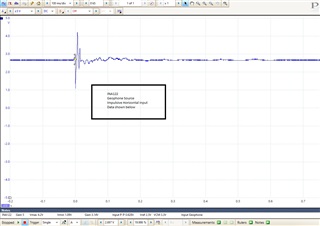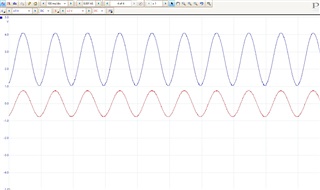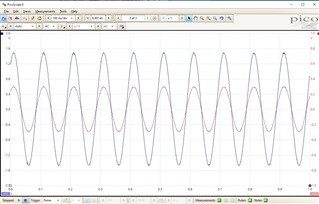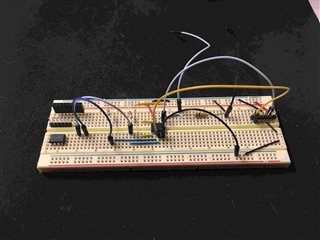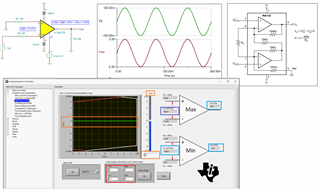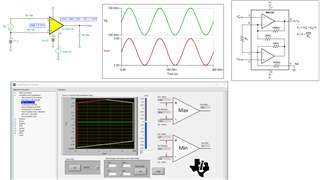I've been working with my TI INA122 with a couple of sources. The configuration for this issue is single supply with pin 4 grounded, pin 3 held at 3.3V, pin 5 held at 2.5V, and pin 7 at 5V. Pins 1 and 8 are unconnected so the gain is 5. Pins 3 and 4 are connected to ground through a pair of 10K resistors (though I have tried others), and of course pins 3 and 4 are connected to the source.
I have used two sources. The first is an Arduino driven 9833 board which has been set up to deliver a sinusoidal output at 10 Hz. This configuration generates a 600 mV ac signal along with a small dc signal. I have inserted a 0.1 microfarad cap on the output to get an ac only signal. The second source is a 10 Hz geophone. The 9833 source is not truly isolated since there is a ground loop, whereas the geophone source has no connection whatever to a ground.
When I run the amplifier with the geophone source, I get a signal centered on 2.5 volts which clips at the expected limits of 1 and 5 V.
When, however, I connect the sinusoidal source I get output pinned to 5V, completely driven to the 5V rail. I have also tried using the signal generator from my scope with the same result. Just on pure instinct, I pulled the 3.3V pin at pin 3 of the 122A, and I got the output sinusoidal waveform, centered on 2.5V, amplified by 5, from 1 to 4 V on the scope. From my understanding, this configuration should not work.
I then tried the 122A in dual mode (V+ 5V, V- -5V) with VCM (pin 3) = 0. Again I got the expected result, an amplified sine wave centered on 2.5 volts. I must say I'm lost for an explanation of this behavior. I get the feeling that something must be amiss with ground, somewhere. The only thing about the 9833 unit is that it has a digital and analog ground, and they're tied together.
I'm including some figures to show what I'm seeing. I'd appreciate any help you might be able to give.
I'm including a few figures which I hope will help. Figure 1 is a trace for a geophone source with the INA122 in single supply mode. With the sinusoidal source, I haven't included a figure showing the output driven to the positive rail because it only shows 5V. However - figure 2 shows the single supply configuration with the sinusoidal source after I pulled the 3.3V Vcm off of pin 3. Finally, Figure 3 shows the output from the same configuration but with a dual +5V -5V power supply and without the 3.3V on pin 3 (obviously).
I've also included a photo of the prototype wired for single supply operation. Black is ground, yellow foreground is 3.3V to pin 3, white is 2.5V to pin 5, and in the background are the plus and minus leads for output. Input pins are at the left middle of the photo.